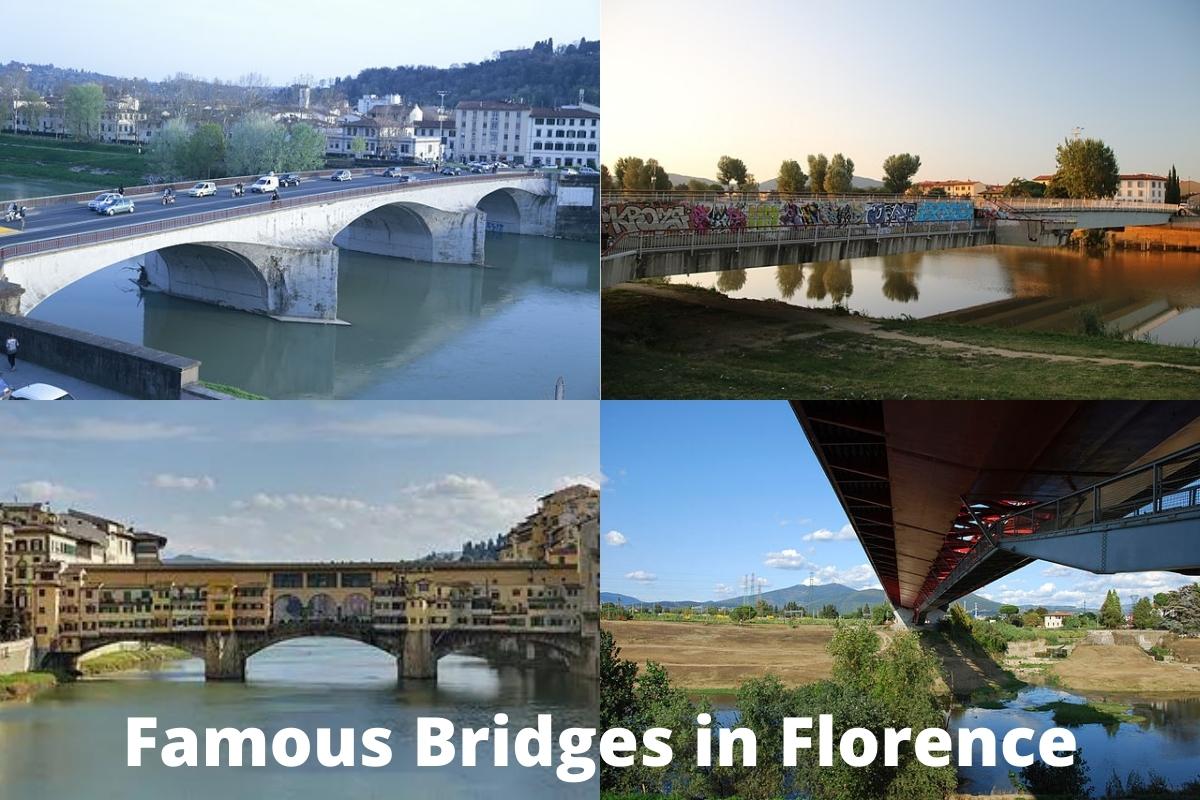Whether you’ve visited Florence or not, you’ve likely heard about the famous bridges in this breathtakingly beautiful and timeless city in Italy.
The city is split in two by the Arno River, yet its lovely bridges help the two halves connect almost seamlessly. Each of Florence’s bridges has a rich history dating back centuries.
In his book Inferno, Dan Brown mentions the Ponte Vecchio, Florence’s oldest and most well-known bridge. The other bridges have interesting narratives and unique features, and are now considered genuine commemorations in this lively and lovely city.
Famous Bridges in Florence
1. Ponte Vecchio
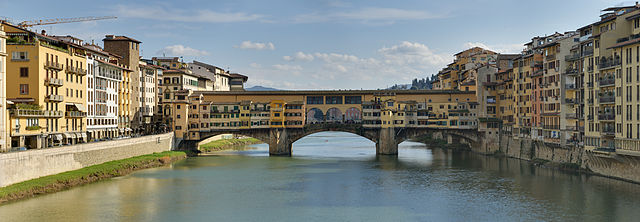
The Ponte Vecchio, also known as the Old Bridge, was constructed not far from the city’s original Roman crossing of the river Arno. This bridge served as Florence’s primary crossing point for the river until 1218.
Also Read: Landmarks in Florence
Following the flood in 1345, the existing bridge had to be constructed. That was the sole bridge over the Arno that the retreating Germans didn’t blow up throughout World War II. Rather, they obstructed the passage by tearing down the medieval structures on either side.
Somehow, on November 4, 1966, after the Arno overflowed its banks again, the bridge managed to withstand the enormous weight of the water and debris.
Also Read: Buildings in Florence
When the Medici family decided to relocate from Palazzo Vecchio to Palazzo Pitti, they realized they would need a way to avoid interaction with the subjects they ruled over by traveling between the Uffizi and Palazzo Pitti across the Arno.
What resulted was the Corridoio Vasariano, which was constructed by Giorgio Vasari in 1565 and extends over the quaint goldsmiths’ shops on the Ponte Vecchio.
A bust of the 16th-century goldsmith Benvenuto Cellini can be found on the bridge. The wooden storefront shutters at night give the area the appearance of trunks and bags, making it an ideal spot for a romantic evening passeggiata. The picturesque setting of Ponte Vecchio in Florence makes for a memorable date.
2. Ponte alle Grazie
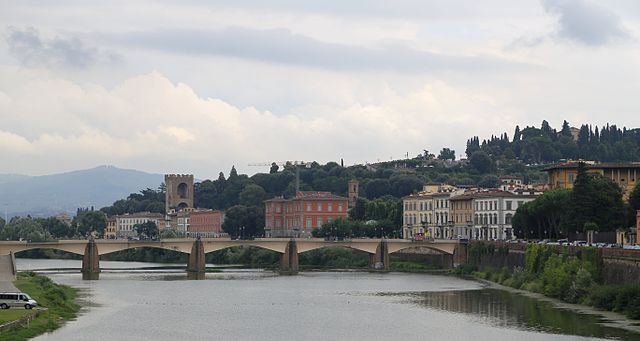
Located at the river’s widest point, it was constructed in 1237 using nine stone arches. The bridge was given its current name, Rubaconte Bridge, in honor of the then-current podestà.
After the devastating flood of 1333, two of the arches on the left side of Ponte alle Grazie were closed in 1347 so that Mozzi square could be enlarged.
In 1292, several religious structures, including chapels and hermitages, as well as commercial establishments, were constructed atop the bridge’s pillars; the bridge was later renamed after the Madonna of Santa Maria alle Grazie, which was created in the late 13th or early 14th century.
Those structures were destroyed in 1876 so trams could pass. In 1944, after the Germans demolished it, a contest for its rebuilding the next year was organized (finished in 1957). A team of architects led by Giovanni Michelucci, who built Florence’s Santa Maria Novella station in Florence, won the competition.
3. Ponte alla Carraia
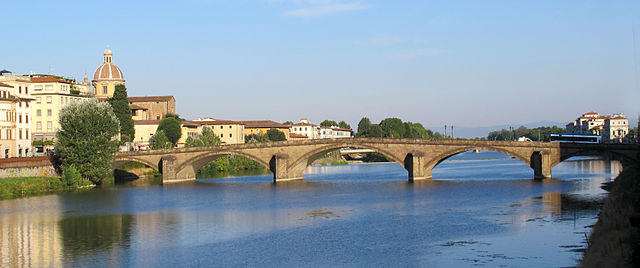
This bridge, which was constructed in 1218, was given the name New Bridge to differentiate it from the older structure. Nonetheless, it was rechristened “Alla Carraia” because it was built for the passage of vehicles.
Multiple collapses, including in 1294 and 1333, necessitated its reconstruction, initially in wood, followed by stone and wood. After it was destroyed in 1557, they reconstructed it entirely out of stone. Up until the Germans demolished it during World War II, it looked the same.
In 1948, they restored the bridge using the same basic design of the original project, which had 5 arches. When it was finally finished in 1952, however, the bridge was heavily condemned by the Florentines for its extremely acute curve, earning it the moniker “the humpbacked bridge.”
4. Ponte Santa Trinita
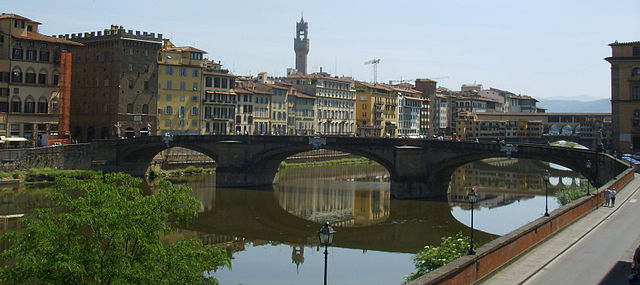
The Holy Trinity Church is the inspiration for the bridge’s name. There has been a wooden bridge on this site since 1252 when nobleman Lamberto Frescobaldi paid for its construction. It collapsed in 1259 and a stone bridge was erected as its replacement, which was destroyed in a flood in 1333.
Between 1346 and 1415, the bridge was rebuilt. However, in 1557, another flood washed it away. When Cosimo I wanted a new bridge built, he hired the Italian architect and artist Bartolomeo Ammannati to do the job. A decade was spent on preparation, and Michelangelo may have had a hand in the design.
Also Read: Famous Bridges in Europe
Three arches are now a structural creation that looks ahead to the taste of the baroque period.
The four allegorical sculptures that adorn the corners as well as the white arches and white scrolls which portray the Four Seasons give the bridge its charm.
They even beautify the triple assisting pylons that help prevent logs getting caught during floods. Both of the latter were set up in 1608 to celebrate Cosimo II’s marriage to Magdalena of Austria.
5. Ponte San Niccolò
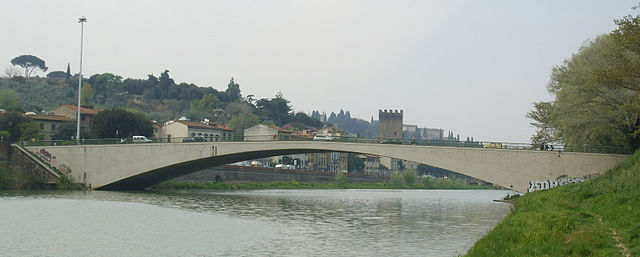
To properly honor King Roberto d’Angi, the ruler of Guelph, who commissioned its construction in 1317, the bridge should have been named Ponte Reale. However, after setting the foundation stone, the Florentines abandoned the bridge project.
It wasn’t until 1837 that construction began on what would become known as the San Ferdinando Bridge, named after a patron saint because of its proximity to the Lorraine region. Initially, it was a suspension bridge, suspended above the Arno River by metal cables.
The first bridge was destroyed by the 1844 flood, but in 1853 it was rebuilt with the same metal framework.
The bridge was first remodeled in 1890 to accommodate tram traffic, but it was eventually decommissioned in 1939.
It was mined and destroyed in World War II, like all other Florentine bridges except the Ponte Vecchio, and rebuilt in 1949 with the current concrete construction, which has a single arch.
This bridge was renamed Ponte San Niccol after the fall of the Lorraine dynasty because it was near the weir of the same name, which provided water to the mills within the walls.
6. Ponte Amerigo Vespucci
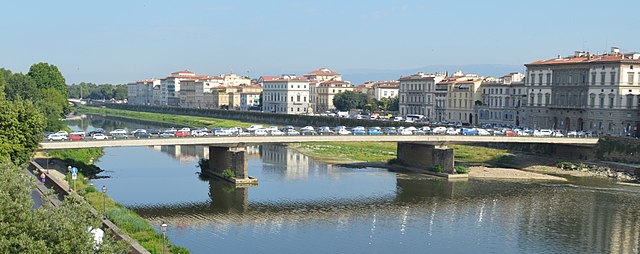
Connecting the Lungarno Soderini with the Lungarno Amerigo Vespucci, this bridge is one of the newest in Florence. A redevelopment plan for the San Frediano neighborhood was first proposed in 1908, but it was never put into action.
In 1949, the first bridge was built and opened to traffic in the San Frediano neighborhood. It was supported by pylon masonry and constructed from salvaged parts of suspension bridges damaged by the fleeing Germans. While San Niccol and Ponte Alla Carraia were being rebuilt, this route was used as an alternative.
The competition to build the new bridge ran from 1952 to 1954, and the building took place from 1955 to 1957. The three separated sections of the bridge resemble a roll of tape when viewed from a distance.
7. Ponte Alla Vittoria
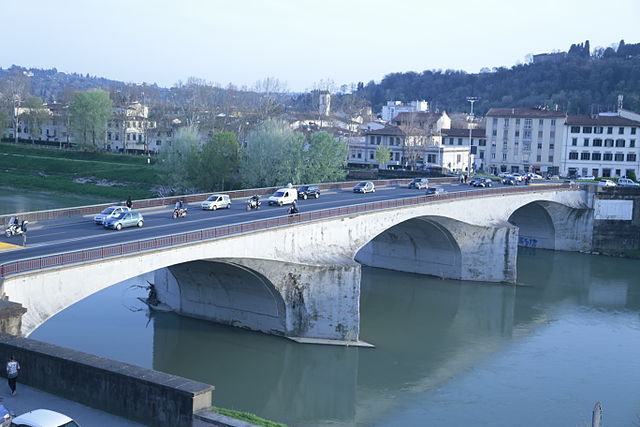
Leopold II ordered the construction of this iron suspension bridge in 1835. The town was honored by the Lorraine by having its name changed to San Leopoldo.
In addition to connecting three large provinces (Pisa, Livorno, and Pistoia), the bridge also connected the sea and the railroad to one of Florence’s primary enterprises, the Pignone, which had been founded in the latter part of the 1800s.
The suspension bridge has a metal pillar at all four corners crowned with a solemn marble lion. These lions were later removed.
After Lorraine sailed away, the bridge was referred to as Suspended. When World War I ended, the victory at Vittorio Veneto sparked a renewed effort to repair the bridge, which was given the patriotic name Victory.
After being destroyed by Allied bombing, the bridge was quickly rebuilt with bronze balustrades and three arches to withstand further attacks.
8. Ponte Giovanni da Verrazzano
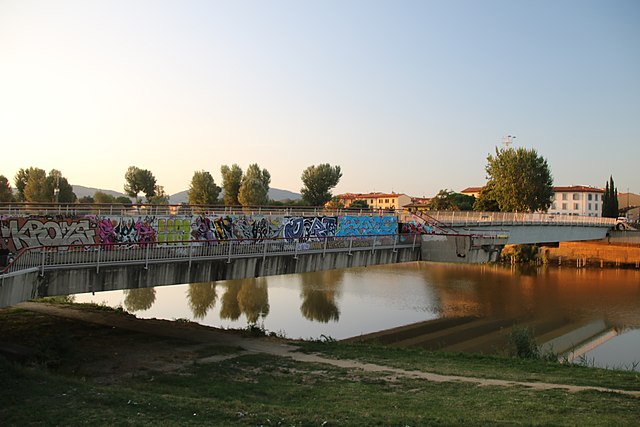
This bridge, which is still in use as a road bridge in Florence, Italy, was built in 1980. It is a girder bridge that was designed by two people, Carlo Damerini and Vittorio Scalese. The famous architect for the project was Leonardo Savioli.
Sitting 12m above the Arno River, this bridge is considered hybrid as it’s made of both steel and concrete. In total, it’s 141m in length. While it might not be the most famous bridge in Florence, this bridge is built quite solid and serves as a major thoroughfare.
Also Read: Beam Bridges
The superstructure of a hybrid concrete-steel bridge comprises two different cross-sections, one built of steel and the other constructed of concrete, connected continuously to allow for transference of shear and axial stresses and flexing. This setup reduces the effective weight of the span.
9. Indiano Bridge
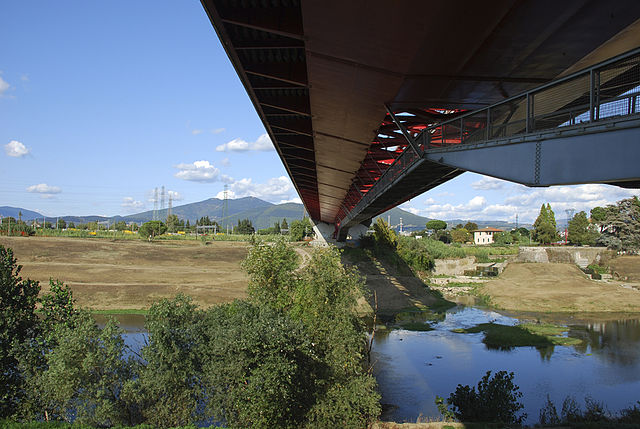
The Indian Bridge, also known as the Viaducto Degli Indi, is the newest in Florence. It was created between 1972 and 1978 and spans the Arno River at the point where the Mugnone brook enters the river. This bridge connects the neighborhoods of Peretola and Isolotto.
The bridge is a roadway earth-anchored cable-stayed bridge having core towers as well as a steel strengthened plate girder made of two trapezoidal box-girders joined by cross-beams plus horizontal braced frames.
Two box girders are joined together by supports plus horizontal braces to form the Indiano Bridge, which is constructed out of steel and iron. As with all of Florence’s other bridges, this one is a remarkable feat of engineering and design.
The bridge was named after Chuttraputti Rajaram, an Indian royal who died at age 21 in the city. His family spread his ashes at the intersection of the Arno and Mugnone, by Hindu tradition. The tomb Dell’Indiano is located nearby.
10. Ponte Della Tramvia
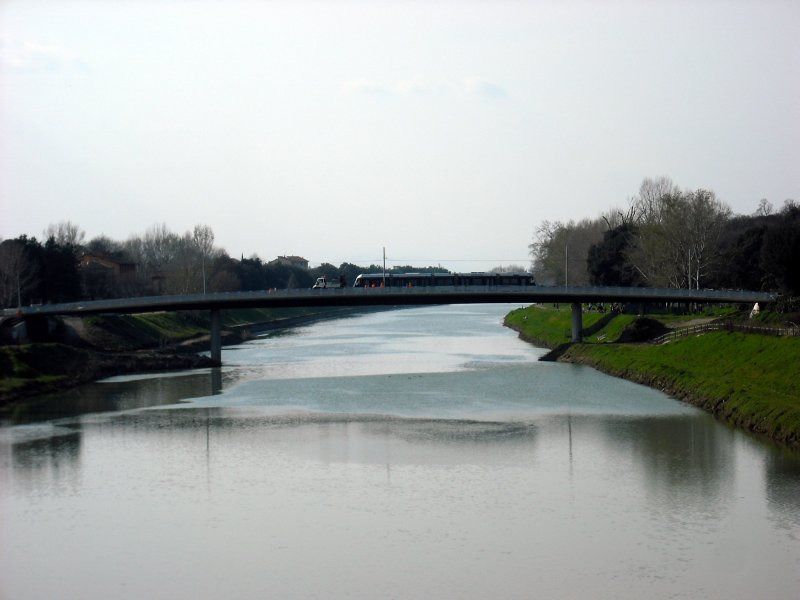
Florence’s line 1 of the city’s tramway crosses over this bridge.
It connects Piazza Paolo Uccello and Viale Stendhal across the Arno river. That bridge’s construction was for trams on line one of Florence’s tramways to cross the river, although it is also open to walkers and cyclists. From an engineering perspective, it is the most important project along Line one.
The tramway bridge is a newer, two-way viaduct that stretches for 124 meters. Its deck is made of COR-TEN steel with a maximum thickness of 22.80 meters at the rear, narrowing to 14.70 meters at the middle.
Two pillars made of reinforced concrete hold up the building. The tramway section is 8 m wide in the middle, with two separate walkways and bike lanes on either side.

